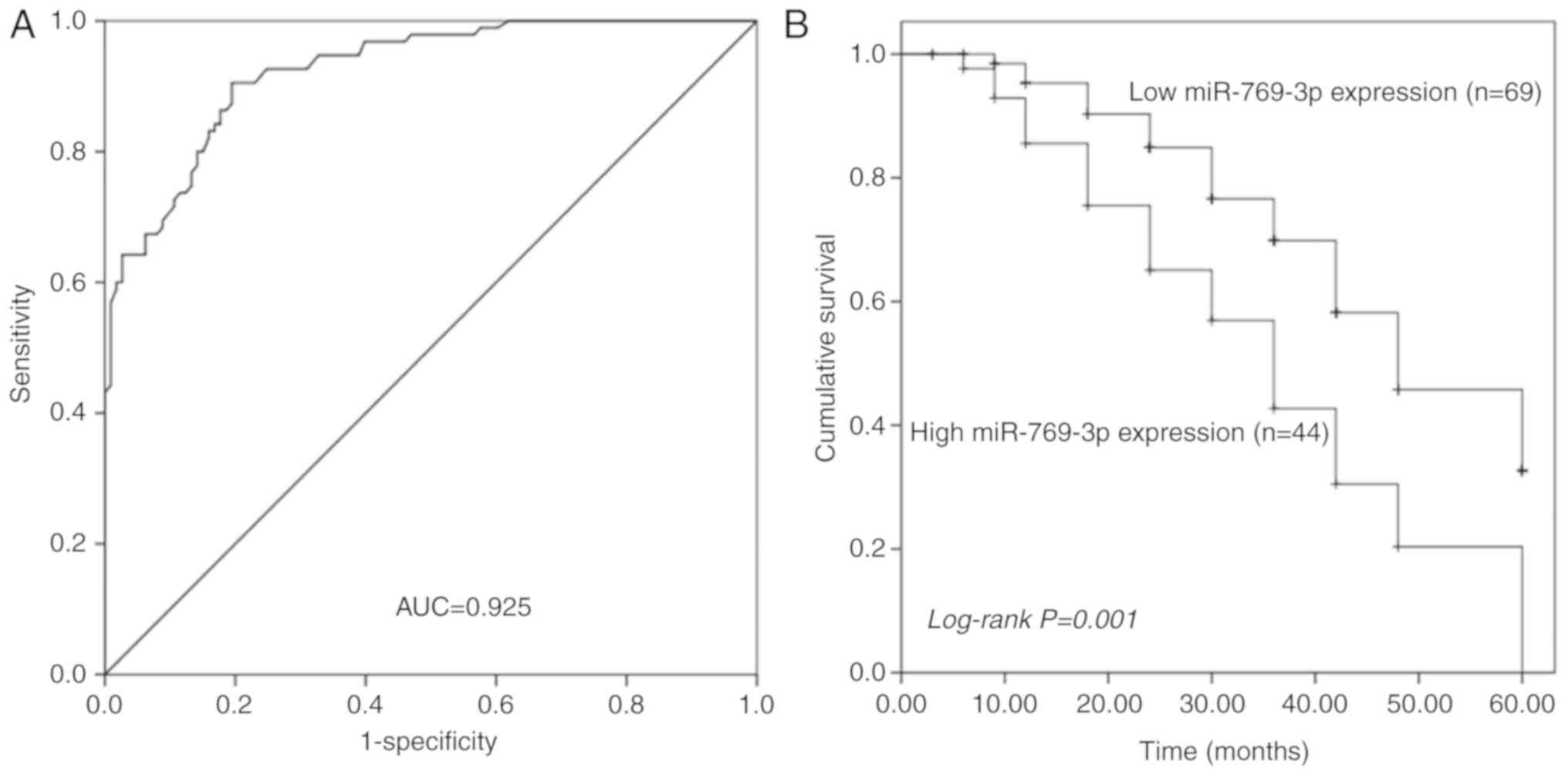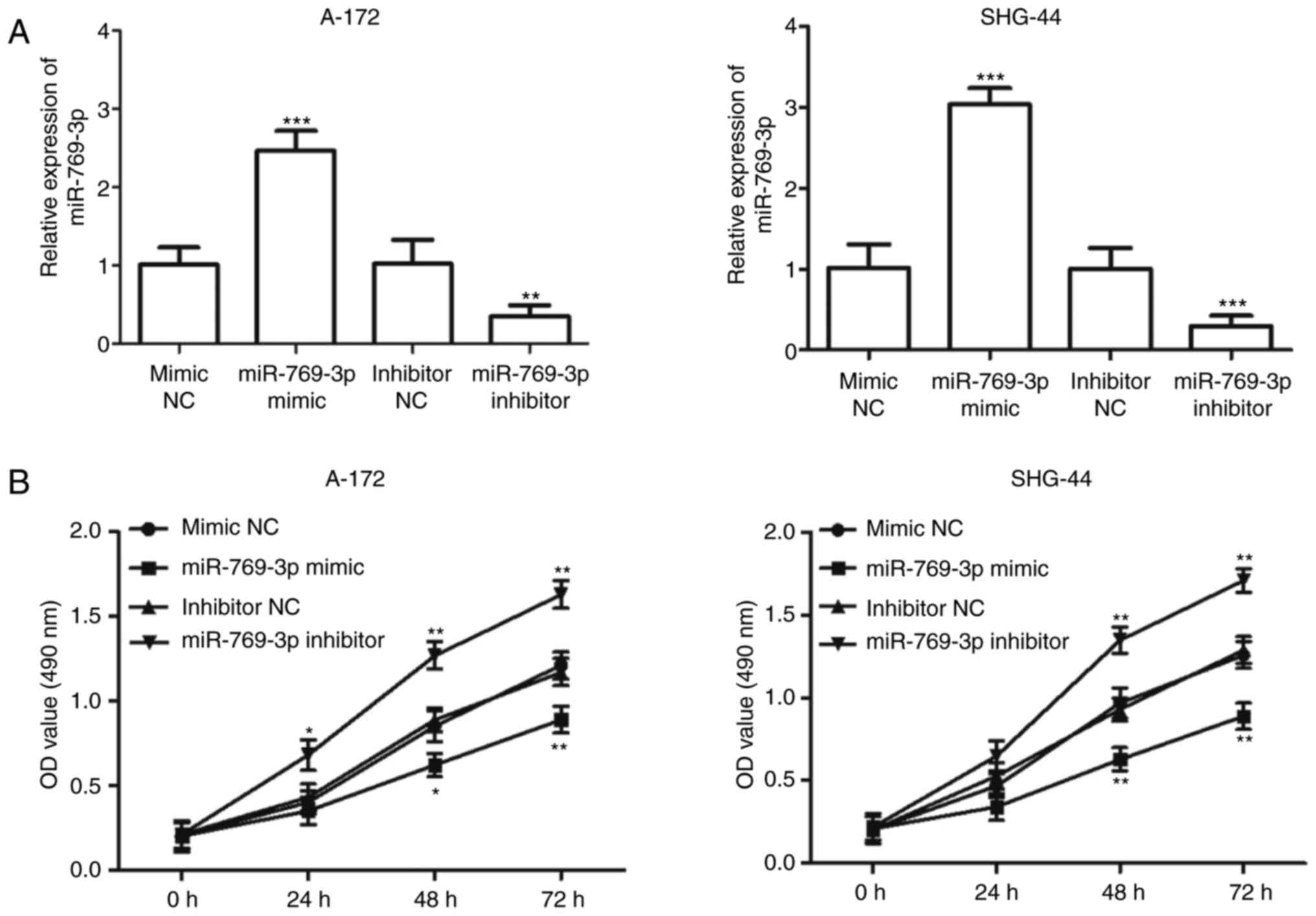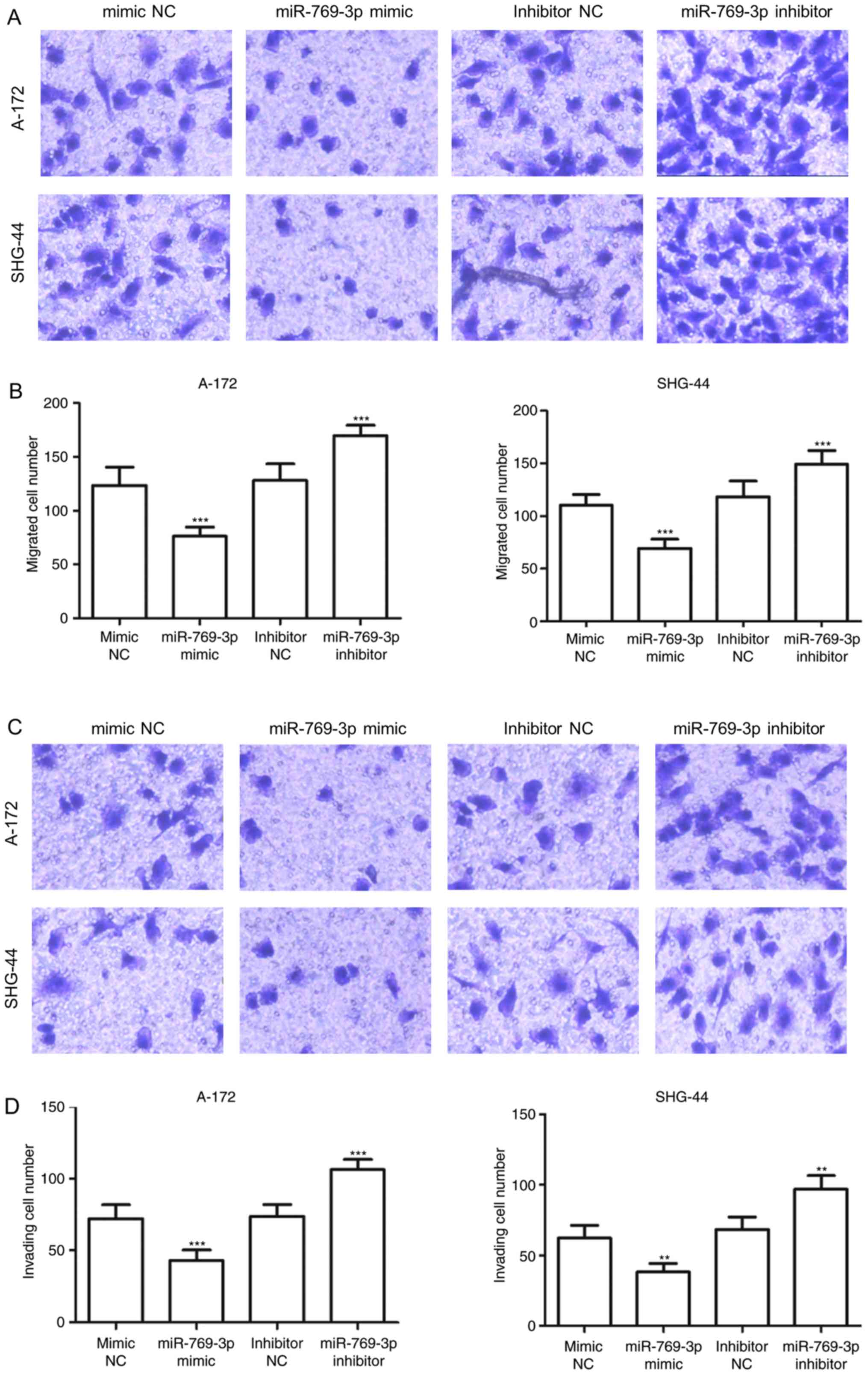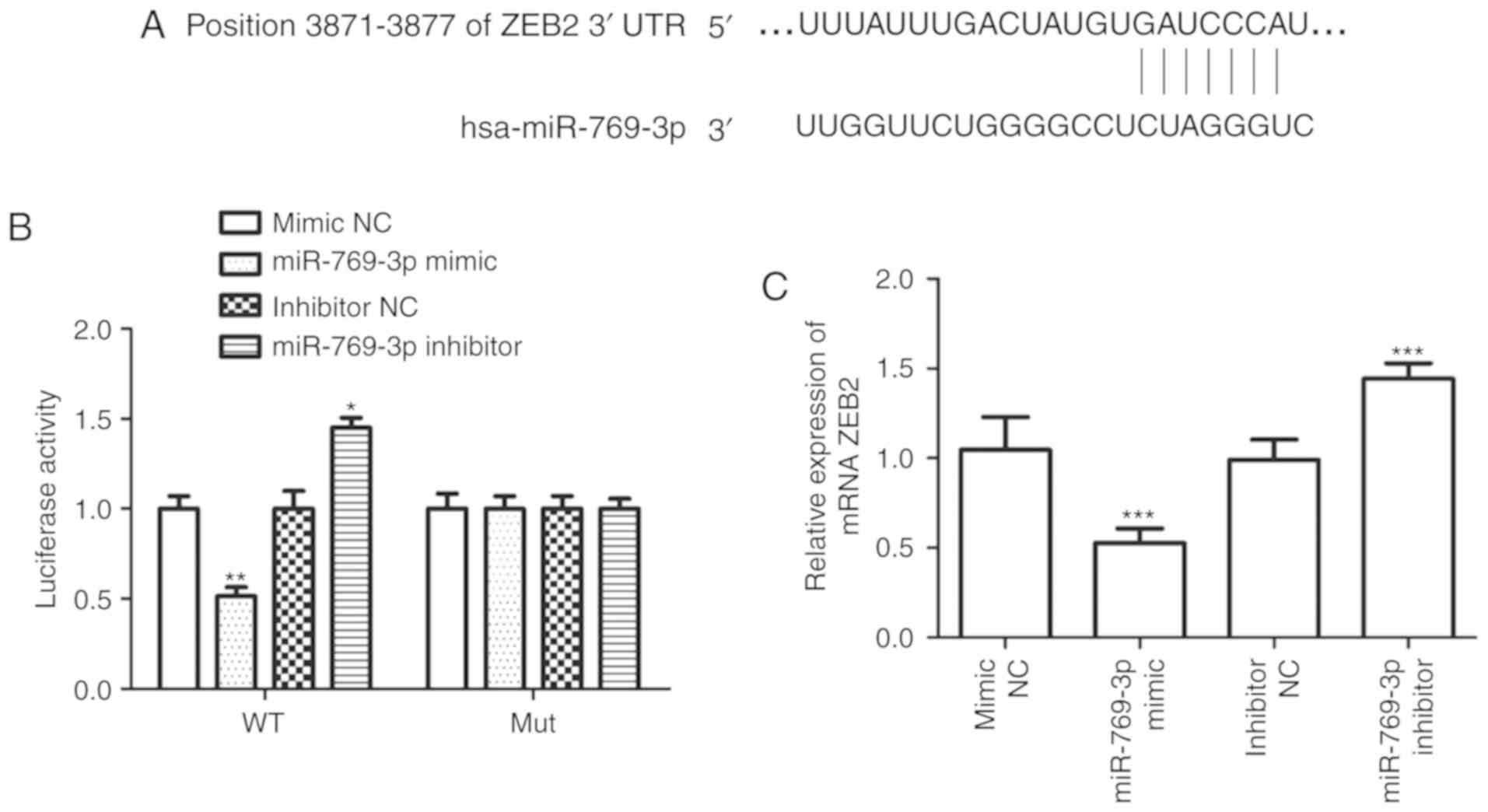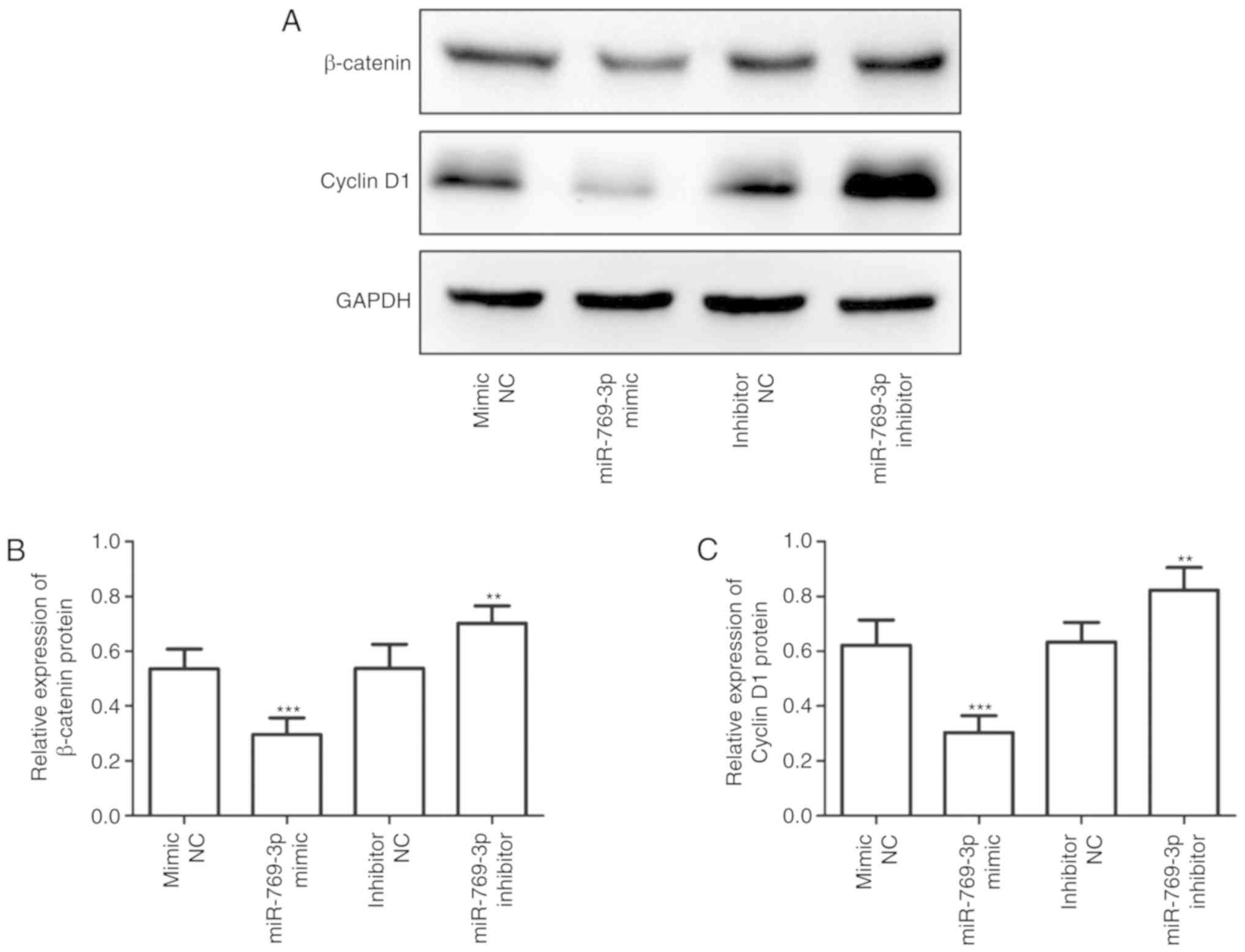|
1
|
Liang J, Zhang XL, Li S, Xie S, Wang WF
and Yu RT: Ubiquitin-specific protease 22 promotes the
proliferation, migration and invasion of glioma cells. Cancer
Biomark. 23:381–389. 2018. View Article : Google Scholar : PubMed/NCBI
|
|
2
|
Zhao W, Yin CY, Jiang J, Kong W, Xu H and
Zhang H: MicroRNA-153 suppresses cell invasion by targeting SNAI1
and predicts patient prognosis in glioma. Oncol Lett. 17:1189–1195.
2019.PubMed/NCBI
|
|
3
|
Yang D, Yuan Y, Zhang S, Zhao K, Li F, Ren
H, Zhang Z and Yu Y: Association between IL-13 Gene rs20541
polymorphism and glioma susceptibility: A meta-analysis. Oncol Res
Treat. 41:14–21. 2018. View Article : Google Scholar : PubMed/NCBI
|
|
4
|
Hu S, Xu L, Li L, Luo D, Zhao H, Li D and
Peng B: Overexpression of lncRNA PTENP1 suppresses glioma cell
proliferation and metastasis in vitro. Onco Targets Ther.
12:147–156. 2019. View Article : Google Scholar : PubMed/NCBI
|
|
5
|
Zhang Z, Huang X, Li J, Fan H, Yang F,
Zhang R, Yang Y, Feng S, He D, Sun W and Xin T: Interleukin 10
promotes growth and invasion of glioma cells by up-regulating KPNA
2 in vitro. J Cancer Res Ther. 15:927–932. 2019. View Article : Google Scholar : PubMed/NCBI
|
|
6
|
Hao B, Chen X and Cao Y: Yes-associated
protein 1 promotes the metastasis of U251 glioma cells by
upregulating Jagged-1 expression and activating the Notch signal
pathway. Exp Ther Med. 16:1411–1416. 2018.PubMed/NCBI
|
|
7
|
Jiang YR, Du JY, Wang DD and Yang X:
miRNA-130a improves cardiac function by down-regulating TNF-α
expression in a rat model of heart failure. Eur Rev Med Pharmacol
Sci. 22:8454–8461. 2018.PubMed/NCBI
|
|
8
|
Wu YF, Ou CC, Chien PJ, Chang HY, Ko JL
and Wang BY: Chidamide-induced ROS accumulation and
miR-129-3p-dependent cell cycle arrest in non-small lung cancer
cells. Phytomedicine. 56:94–102. 2018. View Article : Google Scholar : PubMed/NCBI
|
|
9
|
Chen X and Wang A: Clinical significance
of miR-195 in hepatocellular carcinoma and its biological function
in tumor progression. Onco Targets Ther. 12:527–534. 2019.
View Article : Google Scholar : PubMed/NCBI
|
|
10
|
Huang S, Zheng S, Cheng H, Lin Y, Wen Y
and Lin W: Flot2 targeted by miR-449 acts as a prognostic biomarker
in glioma. Artif Cells Nanomed Biotechnol. 47:250–255. 2019.
View Article : Google Scholar : PubMed/NCBI
|
|
11
|
Lu GF, Geng F, Xiao Z, Chen YS, Han Y, You
CY, Gong NL, Xie ZM and Pan M: MicroRNA-6807-3p promotes the
tumorigenesis of glioma by targeting downstream DACH1. Brain Res.
1708:47–57. 2019. View Article : Google Scholar : PubMed/NCBI
|
|
12
|
Liu F, Xiong Y, Zhao Y, Tao L, Zhang Z,
Zhang H, Liu Y, Feng G, Li B, He L, et al: Identification of
aberrant microRNA expression pattern in pediatric gliomas by
microarray. Diagn Pathol. 8:1582013. View Article : Google Scholar : PubMed/NCBI
|
|
13
|
Han C, Song Y and Lian C: MiR-769 inhibits
colorectal cancer cell proliferation and invasion by targeting
HEY1. Med Sci Monit. 24:9232–9239. 2018. View Article : Google Scholar : PubMed/NCBI
|
|
14
|
Zhang CJ and Du HJ: Screening key miRNAs
for human hepatocellular carcinoma based on miRNA-mRNA functional
synergistic network. Neoplasma. 64:816–823. 2017. View Article : Google Scholar : PubMed/NCBI
|
|
15
|
Ju Q, Zhao L, Gao J, Zhou L, Xu Y, Sun Y
and Zhao X: Mutant p53 increases exosome-mediated transfer of
miR-21-3p and miR-769-3p to promote pulmonary metastasis. Chin J
Cancer Res. 31:533–546. 2019. View Article : Google Scholar : PubMed/NCBI
|
|
16
|
Livak KJ and Schmittgen TD: Analysis of
relative gene expression data using real-time quantitative PCR and
the 2(-Delta Delta C(T)) method. Methods. 25:402–408. 2001.
View Article : Google Scholar : PubMed/NCBI
|
|
17
|
Komori T: The 2016 WHO classification of
tumours of the central nervous system: The major points of
revision. Neurol Med Chir (Tokyo). 57:301–311. 2017. View Article : Google Scholar : PubMed/NCBI
|
|
18
|
Zhang F, Wu A, Wang Y and Liu J:
miR-490-3p functions as a tumor suppressor in glioma by inhibiting
high-mobility group AT-hook 2 expression. Exp Ther Med. 18:664–670.
2019.PubMed/NCBI
|
|
19
|
Ostrom QT, Bauchet L, Davis FG, Deltour I,
Fisher JL, Langer CE, Pekmezci M, Schwartzbaum JA, Turner MC, Walsh
KM, et al: The epidemiology of glioma in adults: A ‘state of the
science’ review. Neuro Oncol. 16:896–913. 2014. View Article : Google Scholar : PubMed/NCBI
|
|
20
|
Chung DS, Shin HJ and Hong YK: A new hope
in immunotherapy for malignant gliomas: Adoptive T cell transfer
therapy. J Immunol Res. 2014:3265452014. View Article : Google Scholar : PubMed/NCBI
|
|
21
|
Waghmare I, Roebke A, Minata M,
Kango-Singh M and Nakano I: Intercellular cooperation and
competition in brain cancers: Lessons from Drosophila and
human studies. Stem Cells Transl Med. 3:1262–1268. 2014. View Article : Google Scholar : PubMed/NCBI
|
|
22
|
Lima FR, Kahn SA, Soletti RC, Biasoli D,
Alves T, da Fonseca AC, Garcia C, Romao L, Brito J, Holanda-Afonso
R, et al: Glioblastoma: Therapeutic challenges, what lies ahead.
Biochim Biophys Acta. 1826:338–349. 2012.PubMed/NCBI
|
|
23
|
Wang R, Zuo X, Wang K, Han Q, Zuo J, Ni H,
Liu W, Bao H, Tu Y and Xie P: MicroRNA-485-5p attenuates cell
proliferation in glioma by directly targeting paired box 3. Am J
Cancer Res. 8:2507–2517. 2018.PubMed/NCBI
|
|
24
|
Wang LQ, Sun W, Wang Y, Li D and Hu AM:
Downregulation of plasma miR-124 expression is a predictive
biomarker for prognosis of glioma. Eur Rev Med Pharmacol Sci.
23:271–276. 2019.PubMed/NCBI
|
|
25
|
Qiu HJ, Lu XH, Yang SS, Weng CY, Zhang EK
and Chen FC: MiR-769 promoted cell proliferation in human melanoma
by suppressing GSK3B expression. Biomed Pharmacother. 82:117–123.
2016. View Article : Google Scholar : PubMed/NCBI
|
|
26
|
Zhang W, Zhao W, Ge C, Li X, Yang X, Xiang
Y and Sun Z: Decreased let-7b is associated with poor prognosis in
glioma. Medicine (Baltimore). 98:e157842019. View Article : Google Scholar : PubMed/NCBI
|
|
27
|
Epifanova E, Babaev A, Newman AG and
Tarabykin V: Role of Zeb2/Sip1 in neuronal development. Brain Res.
1705:24–31. 2019. View Article : Google Scholar : PubMed/NCBI
|
|
28
|
Li Y, Zhang J, Zhang W, Liu Y, Wang K,
Zhang Y, Yang C, Li X, Shi J, Su L and Hu D: MicroRNA-192 regulates
hypertrophic scar fibrosis by targeting SIP1. J Mol Histol.
48:357–366. 2017. View Article : Google Scholar : PubMed/NCBI
|
|
29
|
Ji H, Sang M, Liu F, Ai N and Geng C:
miR-124 regulates EMT based on ZEB2 target to inhibit invasion and
metastasis in triple-negative breast cancer. Pathol Res Pract.
215:697–704. 2019. View Article : Google Scholar : PubMed/NCBI
|
|
30
|
Li H, Xu L, Zhao L, Ma Y, Zhu Z, Liu Y and
Qu X: Insulin-like growth factor-I induces epithelial to
mesenchymal transition via GSK-3βand ZEB2 in the BGC-823 gastric
cancer cell line. Oncol Lett. 9:143–148. 2015. View Article : Google Scholar : PubMed/NCBI
|
|
31
|
Zou Y, Ouyang Q, Wei W, Yang S, Zhang Y
and Yang W: FAT10 promotes the invasion and migration of breast
cancer cell through stabilization of ZEB2. Biochem Biophys Res
Commun. 506:563–570. 2018. View Article : Google Scholar : PubMed/NCBI
|
|
32
|
Zhang X, Xu X, Ge G, Zang X, Shao M, Zou
S, Zhang Y, Mao Z, Zhang J, Mao F, et al: miR498 inhibits the
growth and metastasis of liver cancer by targeting ZEB2. Oncol Rep.
41:1638–1648. 2019.PubMed/NCBI
|
|
33
|
Suzuki K, Kawataki T, Endo K, Miyazawa K,
Kinouchi H and Saitoh M: Expression of ZEBs in gliomas is
associated with invasive properties and histopathological grade.
Oncol Lett. 16:1758–1764. 2018.PubMed/NCBI
|
|
34
|
Qi S, Song Y, Peng Y, Wang H, Long H, Yu
X, Li Z, Fang L, Wu A, Luo W, et al: ZEB2 mediates multiple
pathways regulating cell proliferation, migration, invasion, and
apoptosis in glioma. PLoS One. 7:e388422012. View Article : Google Scholar : PubMed/NCBI
|
|
35
|
Gong X, Liao X and Huang M: LncRNA CASC7
inhibits the progression of glioma via regulating Wnt/β-catenin
signaling pathway. Pathol Res Pract. 215:564–570. 2019. View Article : Google Scholar : PubMed/NCBI
|
|
36
|
Wang Y, Yang Q, Cheng Y, Gao M, Kuang L
and Wang C: Myosin heavy chain 10 (MYH10) gene silencing reduces
cell migration and invasion in the glioma cell lines U251, T98G,
and SHG44 by inhibiting the Wnt/β-catenin pathway. Med Sci Monit.
24:9110–9119. 2018. View Article : Google Scholar : PubMed/NCBI
|
















